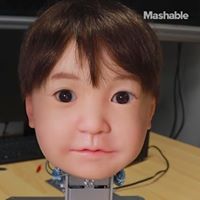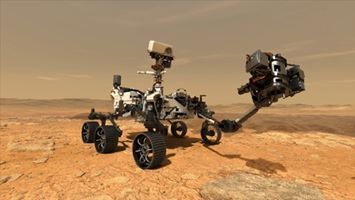In true ‘Blade Runner’ fashion, a child-like robot was taught to wince every time it ‘feels’ pain.

In true ‘Blade Runner’ fashion, a child-like robot was taught to wince every time it ‘feels’ pain.
Andrew Yang today announced the creation of Humanity First, an organization that will fund programs for universal basic income and data as a property right.
But using porous TCP to print bones does have some drawbacks. Its compressive strength is much lower than that of some human load-bearing bones, such as our thighbones. Compressive strength would rise over time, but it could be years before it would match pre-operation strength levels.
3D Printing Bones for Mars?
Several other groups are working on similar approaches. At NYU School of Medicine and NYU Langone Health, scientists have been developing 3D printed scaffold implants that could help patient groups such as children with skull deform ities. Early research results show that up to 77 percent of the bone scaffolding had been absorbed and replaced by natural bone 6 months after surgery, and that the newly-grown bone was just as strong as the original.
BEIJING (Reuters) — A Chinese company says it has developed the country’s first facial recognition technology that can identify people when they are wearing a mask, as most are these days because of the coronavirus, and help in the fight against the disease.
On October 4, 1923, the American composer George Antheil made his highly anticipated Paris debut at the Champs Elysées Theatre, in front of a rioting audience. A few minutes into the recital the crowd became unsettled; members of the audience started to protest the offensive nature of the music, others jumped to the musician’s defence, and before long the house was out of control. Unbeknownst to Antheil, the riot was in fact staged by his friends Marcel L’Herbier and Georgette Leblanc, who needed to film just such a scene for their upcoming movie, The Inhuman Woman. The ruse would only be revealed to him about a year after the incident. As he recalls:
I went to see a movie called L’Inhumaine, featuring Georgette LeBlanc. In this silent movie (still preserved by our New York Museum of Modern Art) you can if you wish see a vast rioting public… However, most curiously, this riot is no fake one. It is an actual riot, the same riot through which I played and lived that night. [1]

The UK Cryonics and Cryopreservation Research Network is a group of UK researchers who, together with international advisors, aim to advance research in cryopreservation and its applications.
Although we are a small group, we hope to promote academic and industrial activity on cryopreservation, and discuss its potential applications, including the idea of cryopreserving whole humans, commonly known as cryonics. We acknowledge that cryonics is a controversial topic, but like any unprovable approach we think its scientific discussion is necessary to permit its understanding by the public and by the wider scientific community, and it allows us to address many of the misunderstandings surrounding cryonics. We also think that cryopreservation, cryogenics and cryonics are fields with a huge potential impact on human medicine whose societal implications should be considered and debated.
Continue reading “UK Cryonics and Cryopreservation Research Network” »
In the era of modern world, medicals advances are evident everywhere. Recently, a team of doctors, researchers and scientists have collaborated to create an electronic biosensor which can be incorporated inside a brain to measure or determine the pH, temperature, flow rates and pressure of the brain. Moreover, it dissolves when no longer needed without the need of any surgical procedure. It is widely applicable in Neuroscience field as brain trauma and injuries kill around 50,000 people per year in the USA alone. These kinds of injuries often cause the brain to swell, which constricts the flow of blood and oxygen, and can lead to permanent damage. So surgeons need reliable ways of monitoring the pressure inside their patients’ head. Earlier, sensors that existed were usually large, heavy and solid, thus had to be removed once the patient recovered. But bioresorbable wireless brain sensors are light, handy and could be easily inserted inside the brain to monitor intracranial pressure and temperature. Once the implantable device is not needed, it is absorbed by the body, eliminating the need of surgically removing the device.
Request sample PDF Brochure Here
Wireless brain sensors are devices that help monitoring the temperature, detecting the intracranial pressure, and record brain signaling in the form of brain waves. The essential aim of this wireless brain sensor is of securing the person from emergency situations. The devices are primarily used for patients experiencing conditions such as sleep disorders, traumatic brain injury, dementia, Parkinson’s disease, and other neurological conditions. These devices aid in observing and monitoring the neurological deviations and provide support for improving the cognitive functionalities. Accessibility of these sensors is easy from a remote area through wireless connectivity and be integrated with smart phones, tablets and computers, consequently be monitored intermittently from a homecare environment, making the device more cost-efficient.
Critical Review of International Social and Political Philosophy: Vol. 22, Special Issue: Political Violence and the Imagination, editors Mihaela Mihai and Mathias Thaler, pp. 542–561.
Before the outbreak, China’s tech industry was already under pressure from the ongoing trade war with the US, which has seen expansion plans crimped by a tighter funding environment and macro economic slowdown. A rapid rise in the number of unemployed could pose a big challenge for the world’s second-largest economy which has seen growth rates already slow to near three-decade lows.
A growing number of Chinese tech-related companies have adopted ‘self-rescue’ plans as the coronavirus epidemic disrupts their business operations.

This week…
🔴 A new name for our next Mars mission: NASA’s Perseverance Mars Rover 🐉 SpaceX’s Dragon launches with supplies for the International Space Station 👩🏽🚀 Applications open to #BeAnAstronaut
